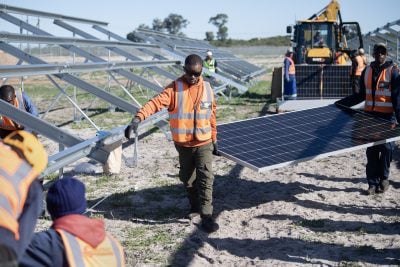Gold prices, having risen for more than 30 years, are now tumbling – with the African gold mining index down 50% in a year. What hope now for Africa’s gold industry? Report by MJ Morgan.
Federal Reserve Chairman Ben
Bernanke may well regret indicating last month that the Fed’s $85bn a month fiscal stimulus programme will not go on forever. In spite of his delicacy of expression, markets reacted like a petulant child divorced from a beloved toy.
Whilst it must be obvious to all that the US’s radical fiscal manoeuvres cannot go on forever, Bernanke’s remarks were enough to contribute to a massive commodity sell-off across the board.
One of the asset classes most severely hammered is gold. Gold rose to nearly $2,000 per oz in 2011, driven by superstition (Keynes’ “barbarous relic”), as a hedge against inflation and fear following the worst global economic catastrophe in a century. However, between April and June gold fell 25%, its biggest quarterly fall since Reuters data began in 1968.
From $1,600 per oz last July, it rose to $1,800 per oz early October before steadily falling back to $1,600 per oz in April.
Gold prices then suffered their fastest two-day fall in 30 years, losing around $200 per oz. June has seen prices fall as low as $1,150 per oz, a level not seen since August 2010, with 19th June seeing a $100 per oz loss in one day.
This is, of course, bad news for gold mining companies and their employees – over 140,000 gold miners in South Africa alone. Mines, particularly high-output-cost mines, are going to be closed or mothballed. Exploration and capital expenditure are likely to suffer with a knock-on effect on the future of the industry.
What matters now is cost. South Africa’s AngloGold Ashanti’s new CEO, Srinivasan Venkatakrishnan estimates 20-25% of gold mines will become uneconomic at $1,300 per oz. All of these mines are likely to be closed or mothballed until prices recover. Cash costs at AngloGold’s new Tropicana project in Australia are estimated to be around $700 per oz so the show will go on.
However, their South African Savuka and Great Noligwa mines are included in those he estimates are uneconomic, given current prices. The company’s shares are currently well over 50% down on the last 12 months, faring worse than gold, which is 20% down on the year.
Newcrest Mining, down 60%, has announced a $5.7bn write-down of its assets – more of a third coming from three mines. One of these is the company’s only mine in Côte d’Ivoire, a ‘higher-cost asset’. Perseus Mining’s Sissingue project in West Africa (down 80%) is likely to be mothballed, according to RBS.
“The industry is not sustainable at $1,230 an ounce, which is where the gold price is at the moment … We’re going to need at least $1,500 an ounce to sustain this industry in any reasonable form,” Gold Fields CEO Nick Holland said.
Sharply falling prices are just the latest of the sector’s serious woes. There are the ever-accelerating wage demands. There are other rising costs, particularly energy, and the greater cost of extraction as mines get deeper and easier to obtain – and thus cheaper – ore becomes more and more scarce.
In addition, the continent’s governments are increasingly questioning the industry’s contribution to wider society. Higher taxes, royalties and bigger ownership stakes for the state or local residents (e.g. Black Economic Empowerment laws in South Africa or Indigenisation in Zimbabwe) are already a reality, with more of the same to come.
The market may appear to have overreacted. But the fact is that fiscal stimulus’s effects are already tapering. Markets know that, short of another massive catastrophe, the only way is down. Hitherto, bad news has perversely resulted in increases in many assets, particularly commodities denominated in dollars, as traders hoped for an increase in fiscal stimulus and bought gold as an inflation hedge.
Additionally, real interest rates in the US turned positive in June, increasing the opportunity cost of holding gold – an asset that provides no return. So, if gold is no longer going to be fiscally fuelled and China’s economy is sneezing, will the rest of us catch a cold? Will bad news now mean an excuse for markets to hammer gold as well as more obvious victims such as oil, copper and iron ore?
If there is no genuine economic recovery, is faith in fiat currencies really wiser than owning gold?
Market hawk Theodore Sirota told African Business, “Bernanke is bluffing and not only cannot exit quantitative easing [fiscal stimulus], but will have to ramp it up as bond yields start to blow up. There will be an almighty rally. The timing is difficult to call though. From the real market, a lot of producers will not be able to mine profitably at these prices and we could see a fall-back in supply but that will take a while to come through.”
If there is a genuine global economic recovery, gold prices will remain depressed until that fact is acknowledged. Demand factors such as jewellery demand (especially in India and China), increased technological activity and production costs will bring it back to the $1,500-$2,000 per oz range.
Challenging times
According to Thomson Reuters GFMS, at $1,200 per oz, half of gold producers are losing money. Below this price, giant South African producers Sibanye Gold, Harmony Gold and Gold Fields are all producing at a loss. Harmony Gold’s South African operations have the highest output costs of the top 12 volume producers, according to Bloomberg, with total costs (i.e. production plus capex) at $1,487 per oz. Sibanye Gold, the country’s second-largest producer, had Q1 total costs of $1,334 per oz. Gold Fields costs were an eye-watering $2,195 per oz, due to its enormous investment in South Deep. AngloGold’s South African operations has total costs of $1,204 per oz.
Gold Fields mines 40% of its gold in Ghana but the company was affected by wildcat strikes in April. Additionally, Ghana’s 2012 budget increased its corporate tax rate for miners from 25% to 35%.
African Barrick Gold, one of Africa’s top five producers, and the largest in Tanzania, has seen its shares fall nearly 75% over the last 12 months. Cash costs average $931 per oz. But at the Tulawaka mine in Tanzania, source of 5% of the company’s gold, cash costs are $1,269 per oz.
AngloGold’s total cash costs are forecast to average $950 per oz over Q2. But with total production cash costs (not including capex) of $1,111 per oz over 2012 for continental Africa (Ghana, Guinea, Mali, Namibia and Tanzania), production is not viable at the current spot price. It has suspended work on its Mongbwalu project in the DRC but is moving forward with the vast Kibali project (a joint venture with Randgold Resources and due to open this year), which has the potential to be one of the biggest gold mines on the continent.
None of this stopped two AngloGold directors from upping their holdings in the company they manage by $200,000 worth of shares in May. But PwC’s 2013 Global Gold Price poll of industry executives found that 88% thought prices would rise over 2013. One would expect them to know, and there is still plenty of year left in these interesting times for investors.
A company like Newmont mines gold in Ghana at a cash cost of $555 per oz so one would think it could handle lower prices and higher taxes. But this is not necessarily the case because of the way miners report their costs.
The World Gold Council has advised producers to change the way they report their costs. The ‘cash-costs’ model significantly understates the actual costs of producing an ounce of gold. Although this is well understood by market analysts, other stakeholders such as unions are given the impression by ‘cash-costs’ figures that gold mining is significantly more profitable than it actually is.
Two new metrics are proposed, ‘all-in sustaining cost’ (all costs required to sustain production) and ‘all-in cost’ (the previous metric plus provision for the lifetime costs of a mine including all capital expenditure).
Wages on the rise
The two biggest unions in South Africa are demanding between 60-100% pay increases. The fast-growing union, the Association of Mineworkers and Construction Union (AMCU), representing 17% of mineworkers, is looking for a minimum entry level wage of $1,250 per month for underground miners – roughly double current levels.
The National Union of Mineworkers, representing 65% of mineworkers, is asking for around $810 per month. Around 85% of workers operate underground.
Mining is an extremely dangerous business (for instance 37 gold miners died in the Central African Republic last month) and miners, many of whom have suffered the stresses and strains of the migrant labour system, understandably want appropriate compensation.
Wages deals last year saw rises of 7-15% but, with South African output falling 7% a year, the industry views double-digit rises as unsustainable. Wages account for about 40% of operational costs on average, according to PwC. The only good news for South African producers is that they receive dollars for their gold sales and pay their workers in rand – which has fallen nearly 20% against the dollar over the last 12 months.
Investment monies are pouring out of the yellow metal. Also damaging is the fact that, to tackle a falling rupee, India has introduced import restrictions.
Central banks bought 535 tonnes in 2012, 12% of demand and the largest quantity since 1964. Looking at the historical record, central banks tend to buy and sell at the worst possible moment. It’s tough times ahead for the continent’s gold sector. Industrial unrest is all too likely.
Want to continue reading? Subscribe today.
You've read all your free articles for this month! Subscribe now to enjoy full access to our content.
Digital Monthly
£8.00 / month
Receive full unlimited access to our articles, opinions, podcasts and more.
Digital Yearly
£70.00 / year
Our best value offer - save £26 and gain access to all of our digital content for an entire year!
 Sign in with Google
Sign in with Google 


